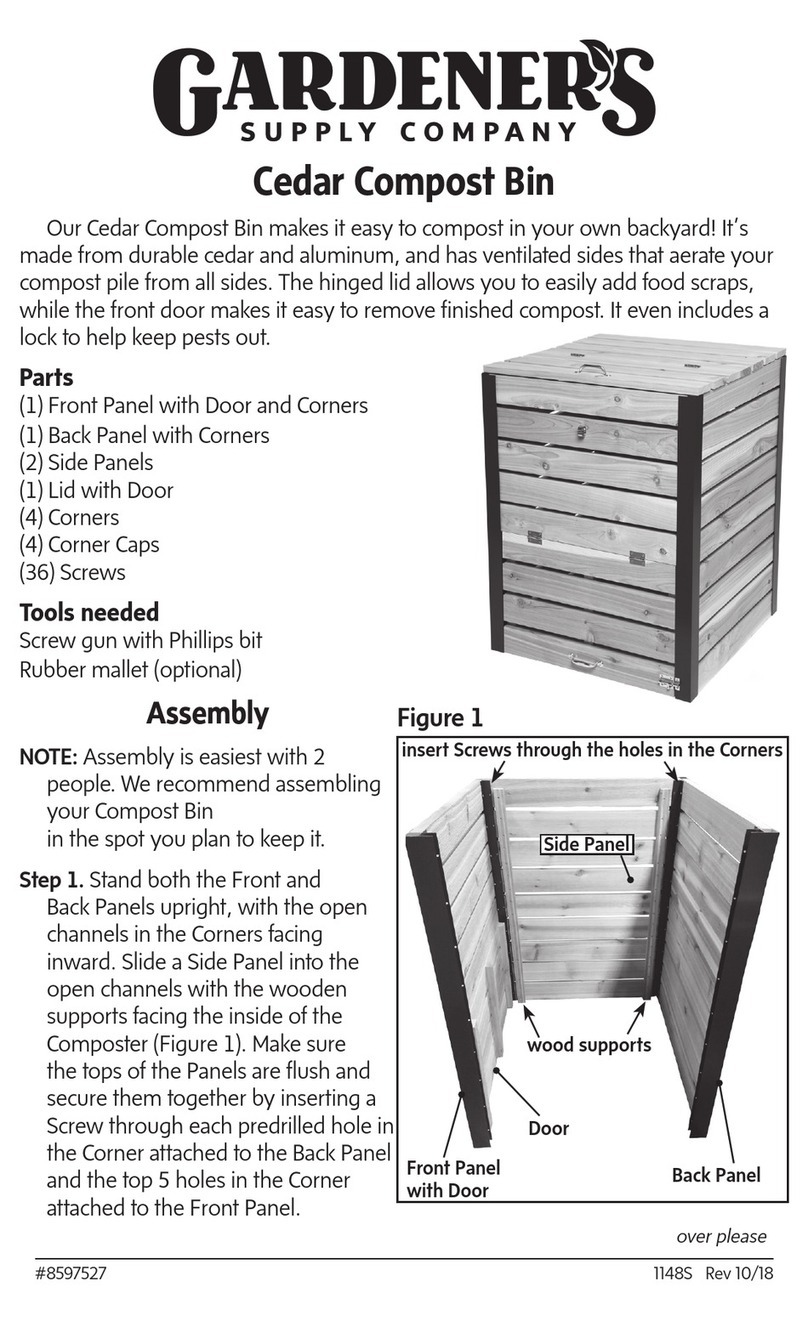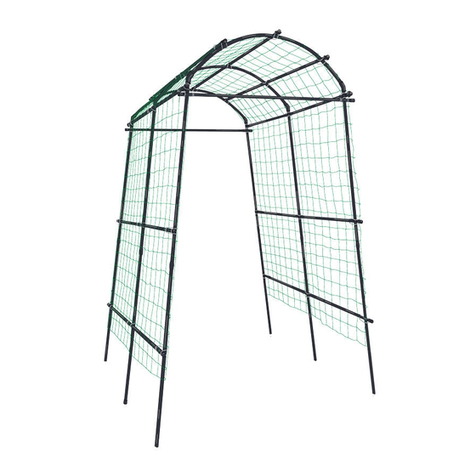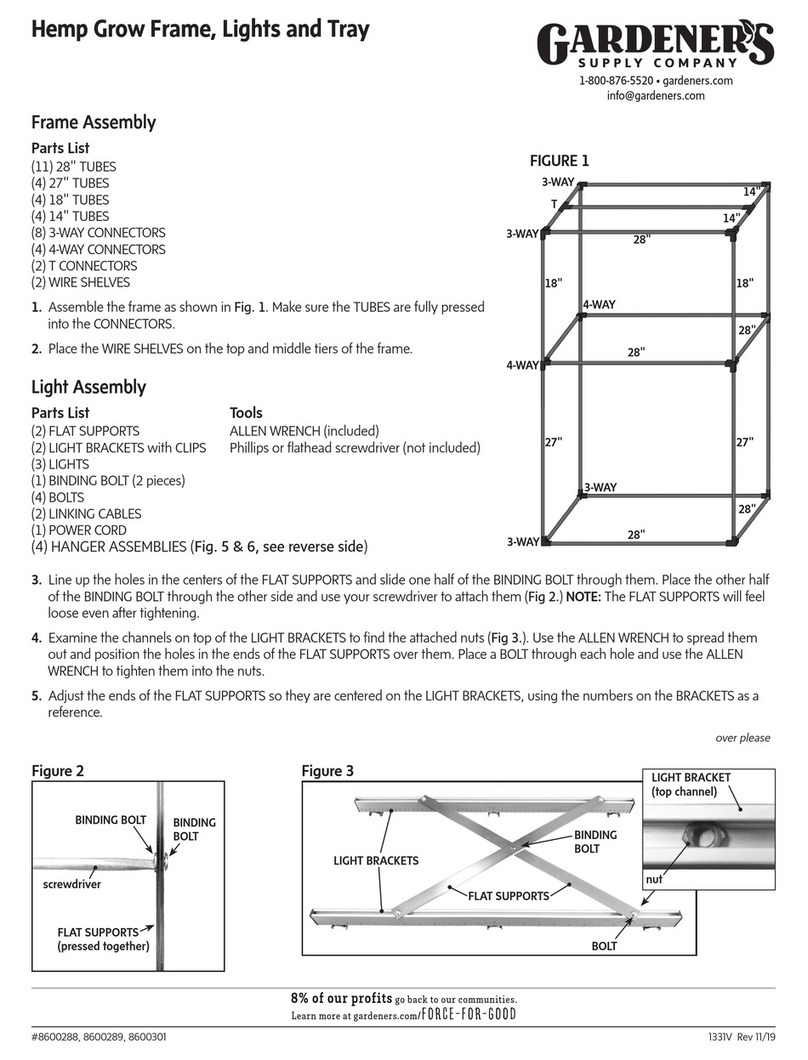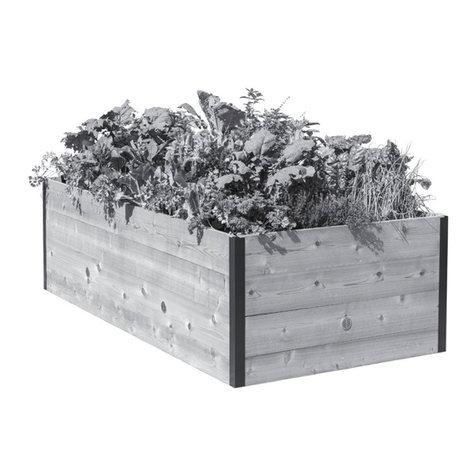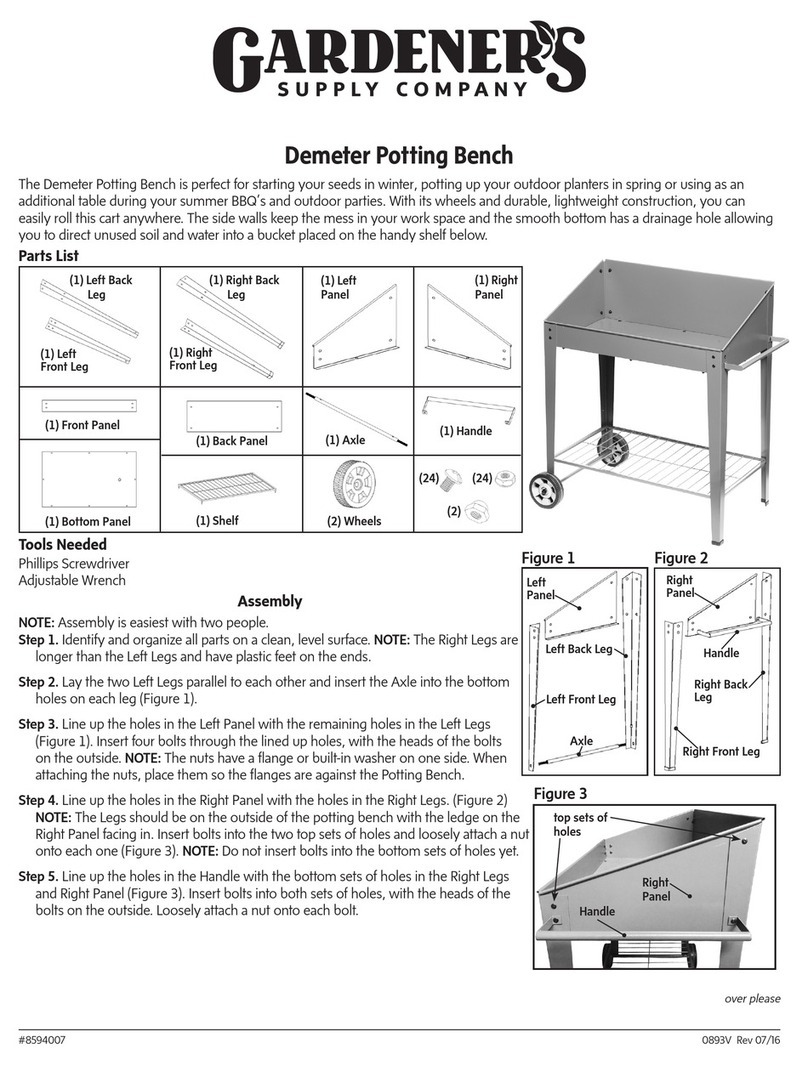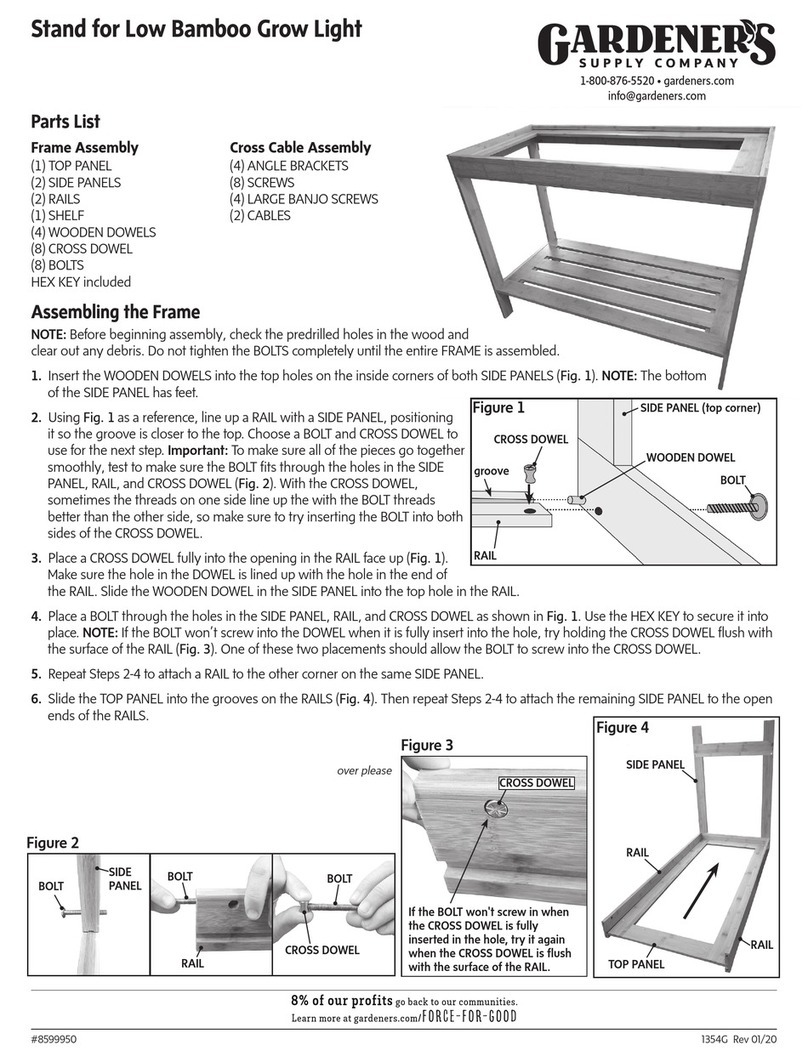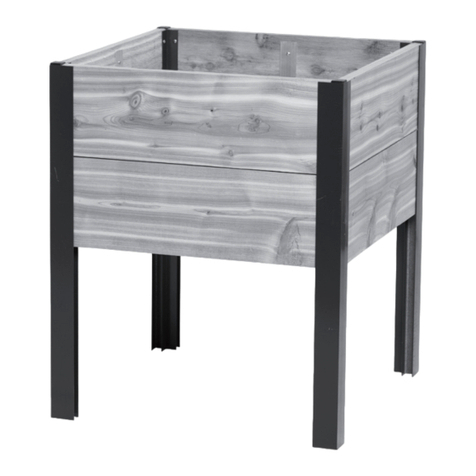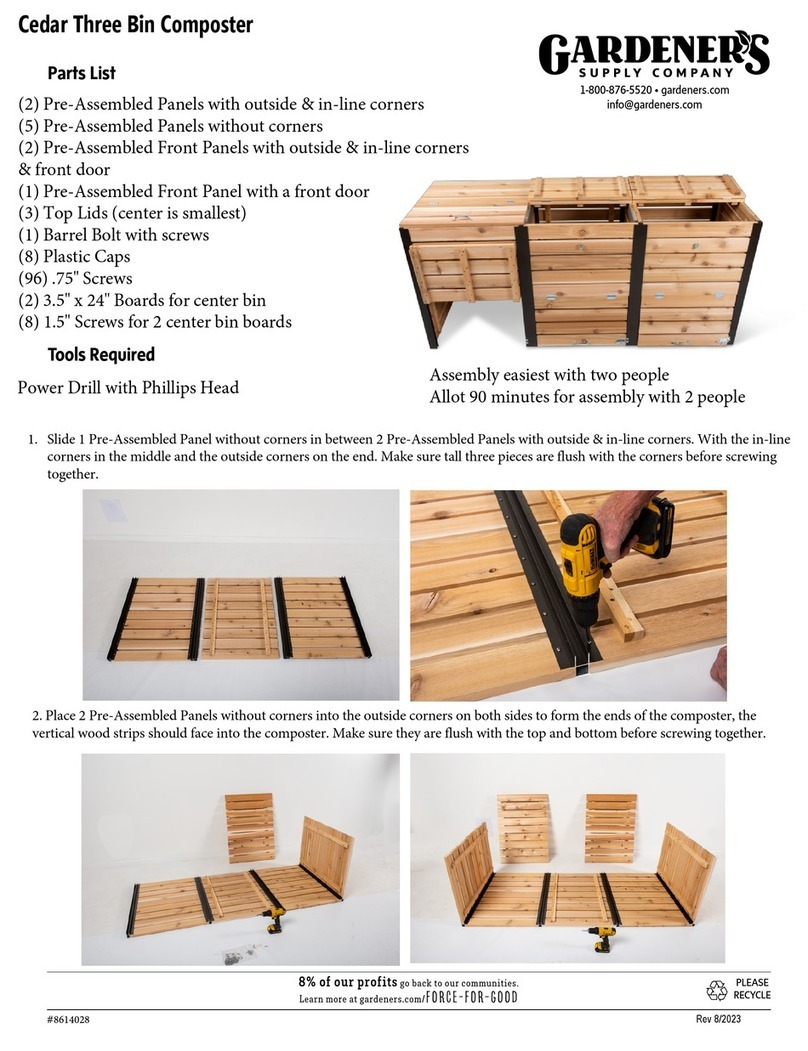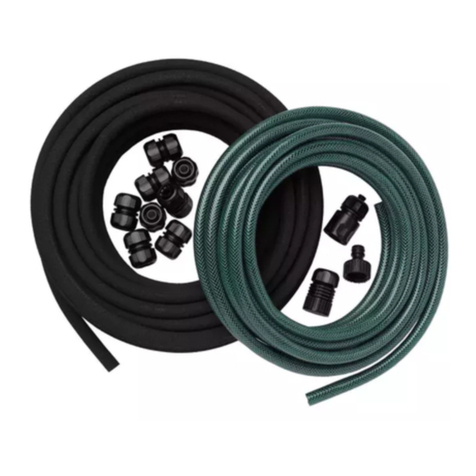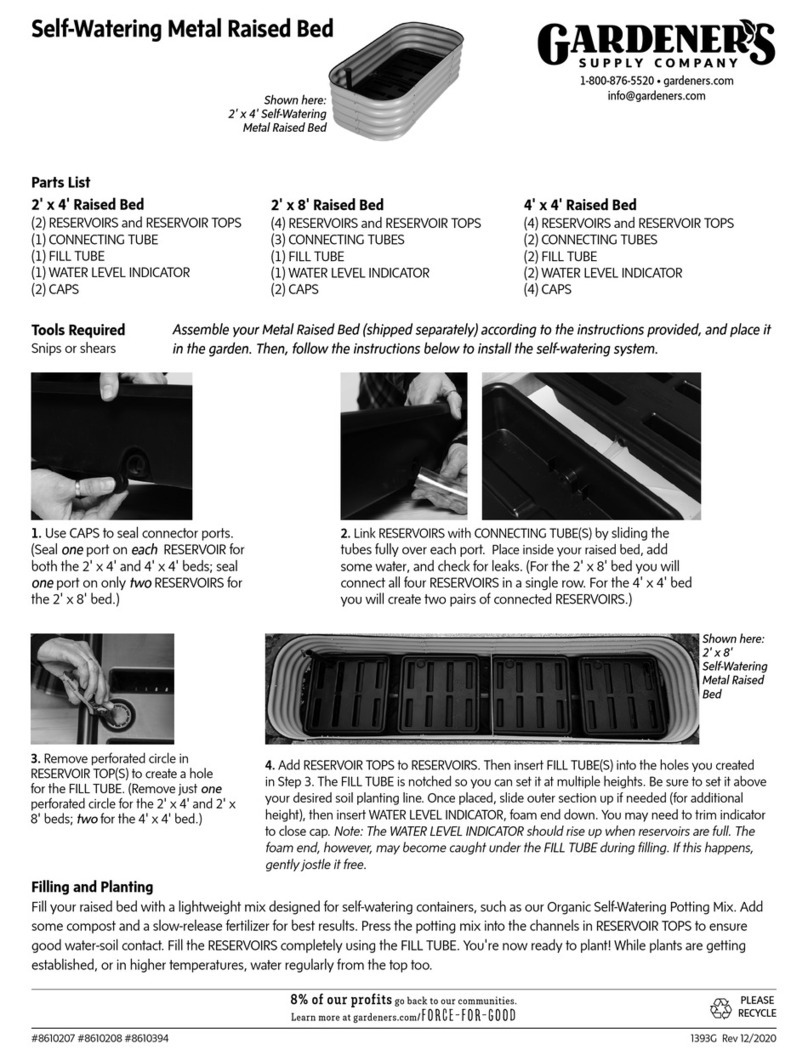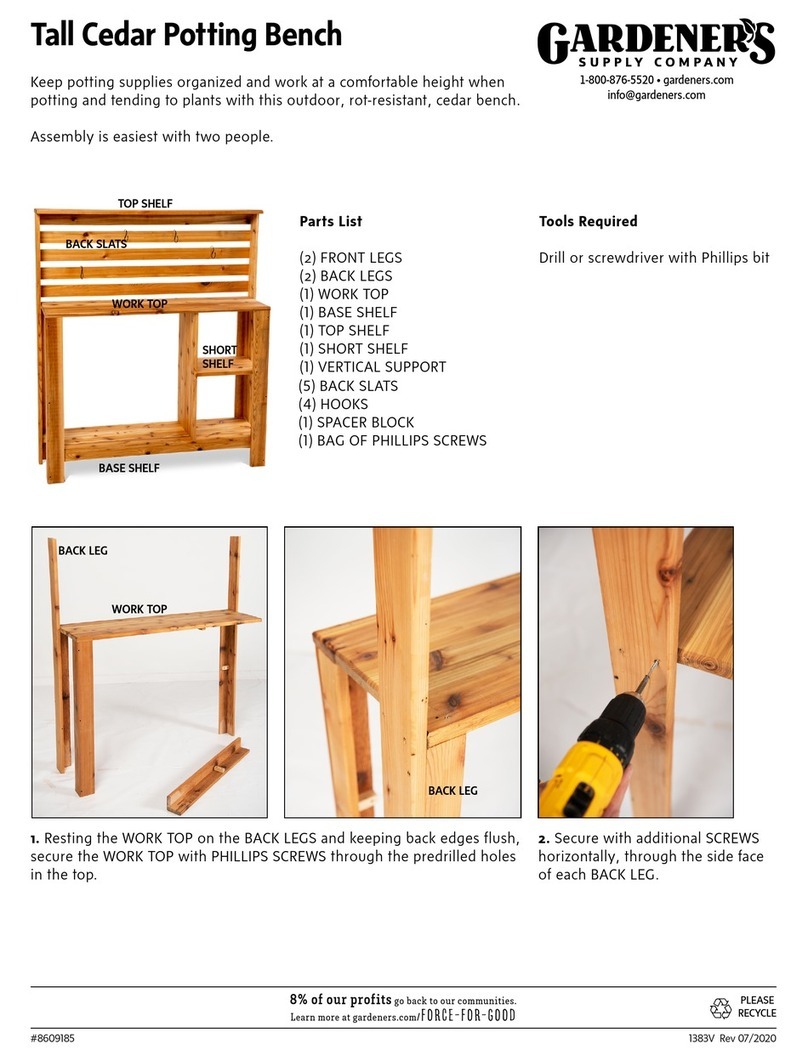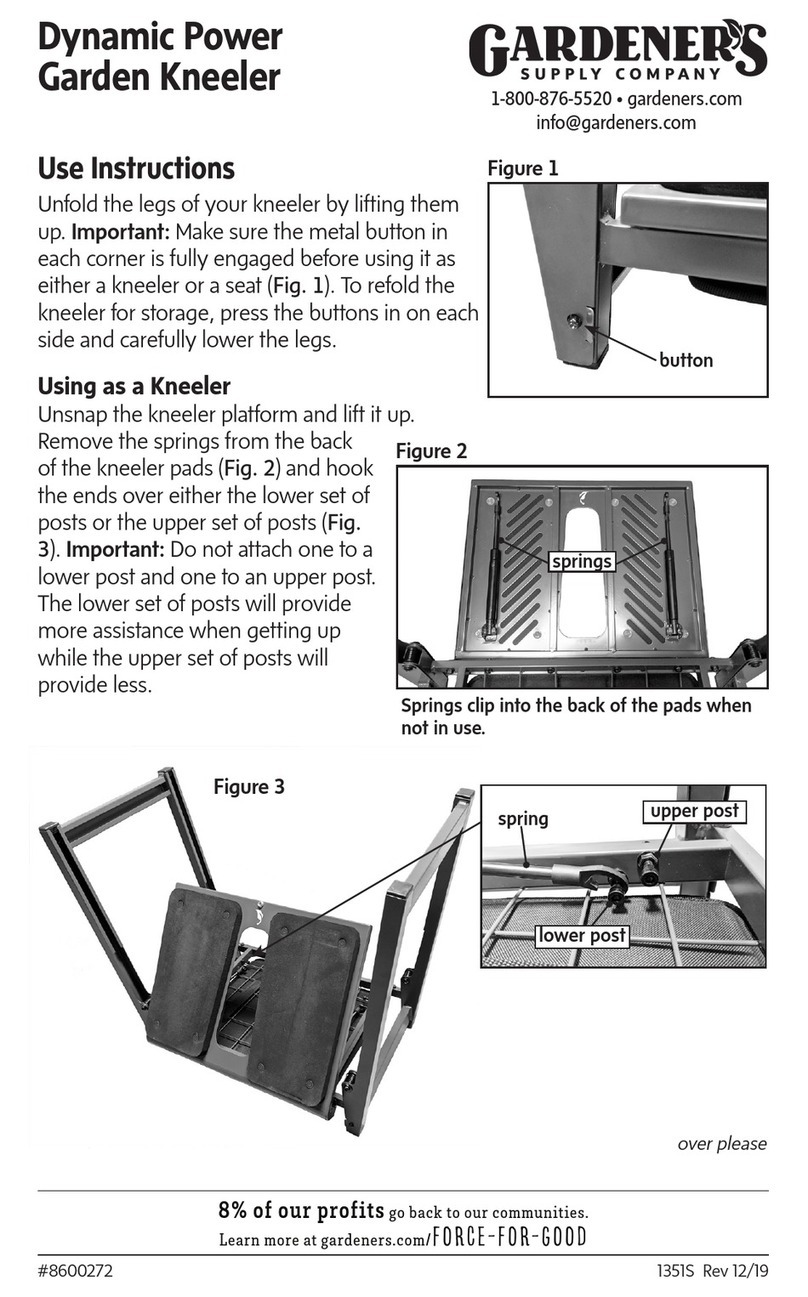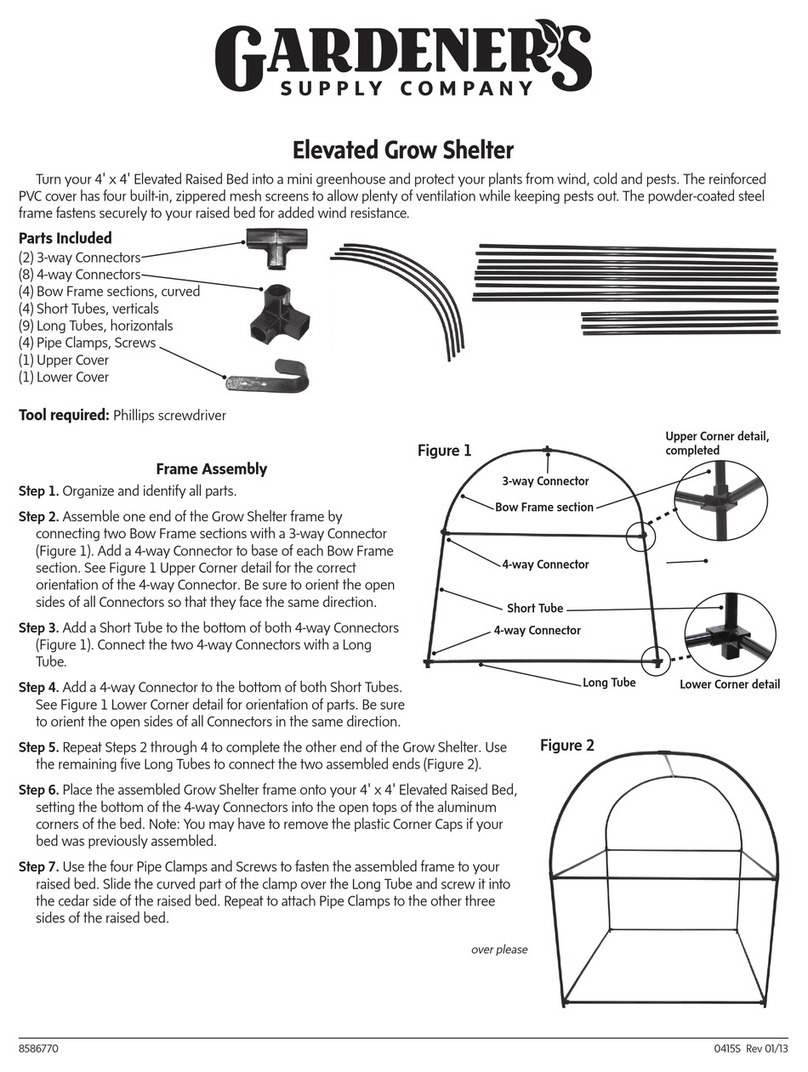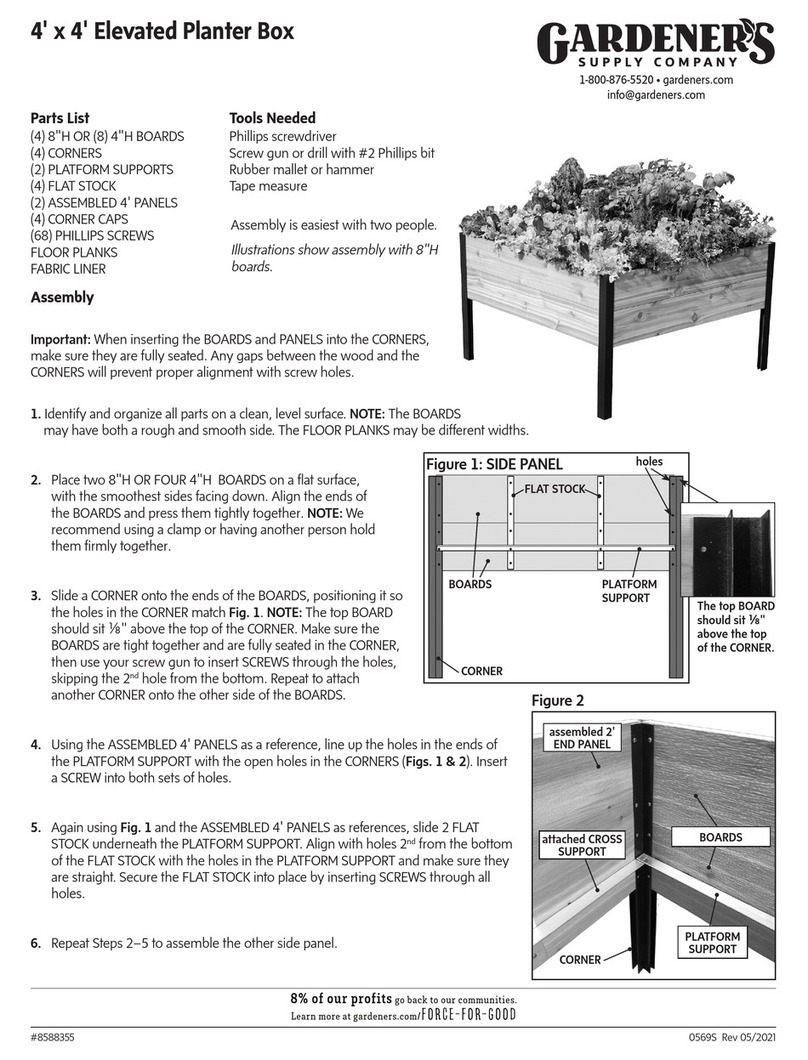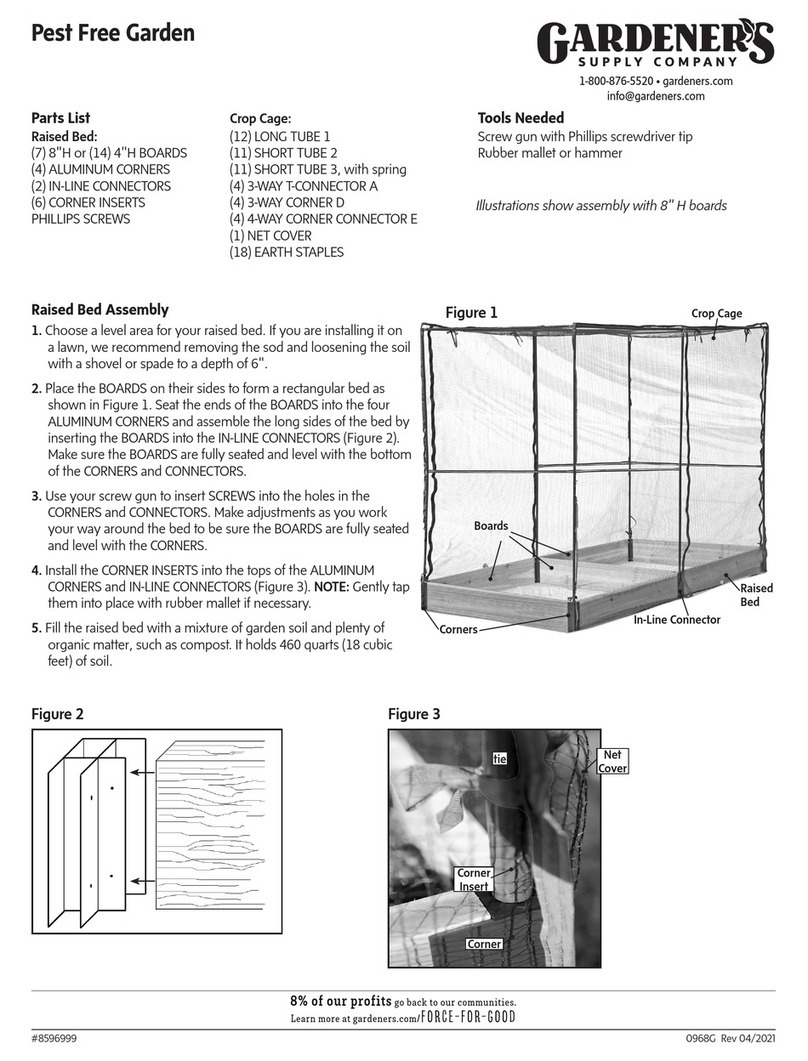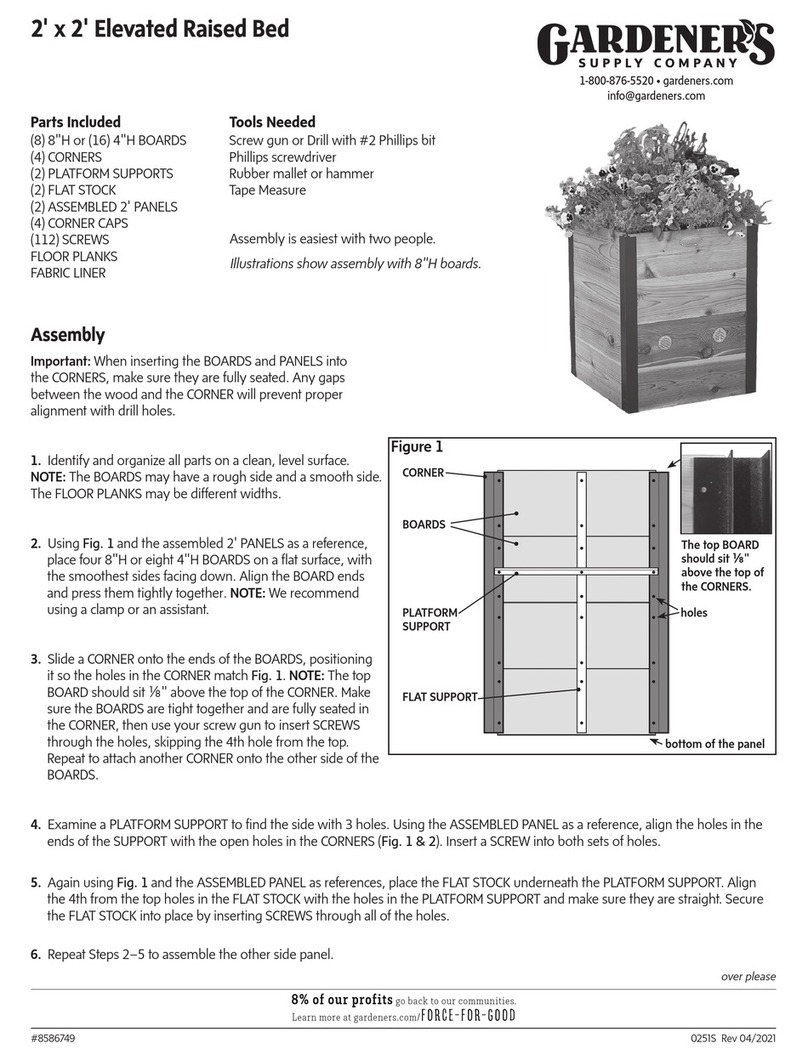
Step 3. Line up the three predrilled
holes along the corner where the
two Panels meet. Place a bolt with
a washer through each hole from
the outside and a washer and wing
nut on each bolt from the inside
and partially tighten, using pliers if
needed.
Step 4. Repeat Steps 1 through
3 to attach the second Vented Panel
to the other side of the Door Panel
(with the Hinge Knob toward the
back).
Step 5. Repeat Steps 1 through
3 to attach the second Door Panel
and Door to the Vented Panels. You
will need to firmly press together
the walls to line up some of the
predrilled holes. You may flip the
composter upside down if the two
bottom holes are too deep to reach
inside to install the hardware.
Step 6. Now tighten all bolts
around all sides of the composter;
however, do not over-tighten, to
avoid damage to the wall of the com-
poster.
Step 7. Turn the composter upright
and look to make sure there are no
gaps between the Panels. This will
ensure that the Doors stay open
when raised. Make sure the Doors
slide freely up and down between
the panels.
Step 8. To attach the Lid, push the
Hinge Shoulders of the Lid onto the
smaller Hinge Knobs at the back of
the composter. Close the lid. Con-
gratulations! The assembly is com-
plete and the composter is ready to
use.
Anchoring the Composter
You can anchor the composter to
the ground using the Anchor “Ears”
molded into the bottom of each
Side Panel (see front page diagram).
If you live in a high wind area or
simply want the extra security of an
anchored composter, we recommend
using Our Extra Tall Earth Staples
(See Ordering Info.).
How Compost Happens
Organic matter is transformed
into compost through the work of
microorganisms, soil fauna, enzymes
and fungi. With the right materials,
the decomposition process can work
very rapidly, sometimes in as little
as 3 to 4 weeks! It all depends on the
kind of environment you provide for
the decomposers to do their work.
Even if you don’t provide the
optimum environment, decomposi-
tion will still happen. Because the
Pyramid Composter is a continuous
composter, you can continue to
add materials to the top of the pile
and remove dark, nutrient-rich
compost below, but it may take
several months.
If you would like to make an
abundance of compost in a short
amount of time, the trick is to
balance the following four things:
Carbon: Carbon-rich materials are
the energy food for microorgan-
isms. You can identify high-carbon
plant materials because they are dry,
tough, or fibrous, and tan or brown
in color. Examples are dry leaves,
straw, rotted hay, sawdust, shredded
paper, and cornstalks.
Nitrogen: High-nitrogen
materials provide the protein-rich
components that microorganisms
require to grow and multiply. Freshly
pulled weeds, fresh grass clippings,
over-ripe fruits and vegetables,
kitchen scraps and other moist green
matter are the sorts of nitrogen-rich
materials you’ll probably have on
hand. Other high-protein organic
matter includes kelp meal, seaweed,
manure and bone meal.
Water: Moisture is very
important for the composting pro-
cess. But too much moisture will
drown the microorganisms, and too
little will dehydrate them.
A general rule of thumb is to keep
the material in your compost pile as
moist as a well-wrung sponge. If you
need to add water, insert your garden
hose into the middle of the pile in
several places, or sprinkle the pile
with water as needed. Keeping the
cover on will make it easier to main-
tain the right moisture level.
Oxygen: To do their work most effi-
ciently, microorganisms require a lot
of oxygen. When your first compost
pile is assembled, there will probably
be plenty of air between the layers
of materials. But as the microorgan-
isms begin to work, they will start
consuming oxygen. Unless you turn
or in some way aerate your compost
pile, they will run out of oxygen
and become sluggish. This will slow
down the decomposition.
Do I Need a Recipe?
Microorganisms and other soil
fauna work most efficiently when
the ratio of carbon-rich to nitrogen-
rich materials in your compost pile
is approximately 25:1. In practical
terms, if you want to have an active
compost pile, you should include
lots of high-carbon “brown” materi-
als (such as straw, wood chips, or dry
leaves) and a lesser amount of high-
nitrogen “green” materials (such as
grass clippings, freshly pulled weeds,
or kitchen scraps).
If your pile has too much nitrogen
and not enough carbon, the pile will
also decompose very slowly and it
will probably be soggy and smelly
along the way. But don’t worry about
the exact carbon content of a mate-
rial or achieving a precise 25:1 ratio.
Composting doesn’t need to be an
exact science. All organic matter
breaks down eventually, no matter
what you do. If you simply use about
3 times as much “brown” materials
as “green” materials, you’ll be off to
a great start.
Composting Tips
* Keep a pile of straw, dry leaves,
or peat moss near your compost pile.
Sprinkle a little on the top of the
pile each time you add fresh weeds
or kitchen scraps. These high-carbon
materials will help keep the carbon/
nitrogen ratio in balance.
* Shredded materials compost
more rapidly. The more surface area
for microbes to attack, the sooner
you’ll have usable compost. You can
chop your materials with a machete
or shovel, run them through a shred-
ding machine, or run over them
with your lawn mower.
* Cover your pile for best results.
It will deter pests, hold in heat, and
keep the moisture level more con-
stant. A pile that’s dry or too wa-
terlogged takes a very long time to
break down.
* In northern states, cover your
pile in late fall to avoid leaching nu-
trients and to prevent the pile from
becoming waterlogged. A drier pile
will thaw more quickly the following
spring.
* If skunks and burrowing rodents
are hanging around your compost
pile, you can use hardware cloth or
purchase a Rodent Screen to place in
the bottom of the composter. Avoid
putting meat or fatty foods in your
pile: they attract all sorts of animals.
Compost not hot: Materials in your
compost may be too dry. This can
happen quickly during the summer.
Try to keep your compost materials
moist to the touch. Inadequate nitro-
gen will also slow things down. Re-
plenish the nitrogen content of your
pile with fresh green grass clippings,
garden weeds, kitchen scraps or an
activator like Super Hot Compost
Starter or Compost Accelerator.
Your pile may also be too small. In
this case, collect more materials to
help increase the microbial activity.
